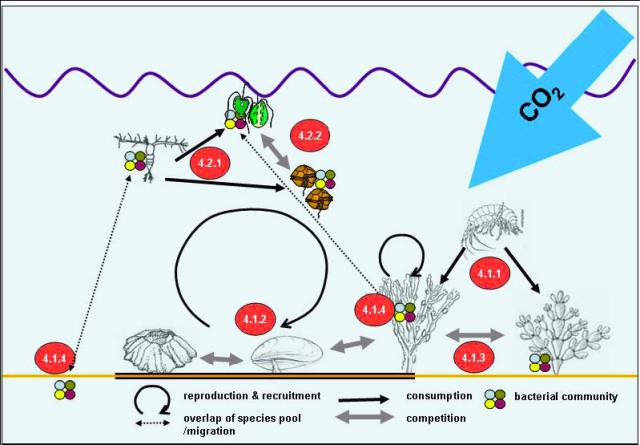BIOACID I – Theme 4: Species Interactions and Community Structure in a Changing Ocean
Overarching questions
- What is the role of differential sensitivities to OA at the community, species and intraspecific (ontogenetic stages, genotypes) level? Are there emerging properties resulting from organism interactions that are not visible from single-species investigations alone?
- Does the community structure change as a consequence of OA and how do shifts in competitive abilities of benthic and pelagic organisms affect community structure?
- What is the role of OA induced changes in food quality and quantity in primary producers to higher trophic levels?
- To which extent will energy transfer between lower and higher trophic levels change as a result of changing competitive interactions and/or changes in the feeding environment?
- Do different types of communities (benthic – pelagic, microbial – macrobial) react differently to acidification/warming stress?
Observed effects of low pH and/or high CO2 conditions are mostly based on experiments with single species. Hence, not much is known about how these factors affect interactions between species and, through that, communities. Indeed, the projected shifts in pCO2 and pH in many species often only slightly impact performance and fitness of a given species, and many studies find reactions in single species experiments only with very high CO2 concentrations or at unrealistically low pH (e.g. Mayor et al. 2007). However, as shown for other stressors (Christensen et al. 2006) ensuing modifications of species interactions may substantially amplify or buffer the original stress (Wahl 2008). How environmental stress spreads through a community via shifts in composition and interaction is still very much an open question.
Theme 4 will therefore address the pivotal role of interaction modulation in close cooperation with a number of projects from other themes which, in contrast, focus on single species reactions to ocean acidification. Thus, Theme 4 is the logical extension of these projects, placing the responses of individual organisms to OA into a community and ecosystem context. We expect to find effects of OA on community structure and interaction that are not visible when studying single organism reactions. Hence, we will focus on shifts in competitive and trophic interactions as well as on community structure. Organisms will vary considerably in their reaction to ocean acidification. As a consequence, formerly superior competitors may be weakened, as is the case in interactions between calcifying and non-calcifying species (e.g. Kuffner et al. 2007), or relative susceptibility to predation may change (Swanson & Fox 2007). Furthermore, there may be strong selective pressures within species, if susceptibility to stress differs between genotypes or between ontogenetic stages. At the unicellular level, less sensitive clones or strains may become more dominant under ocean acidification, and sensitive rare populations may disappear. In multicellular species, the most sensitive ontogenetic phase will determine survival, and genetic diversity may determine the fate of a population under OA.
The changes in species composition on one trophic level will obviously affect the transfer of energy and matter to higher trophic levels. Shifting species composition at the base of the food chain may represent different quality feeds for predators, which may result in a complete restructuring of the trophic web. Also, direct effects of increased CO2 availability may change the quality of organisms as food for higher trophic levels. Higher carbon availability will typically result in higher carbon to nutrient ratios in primary producers. This has on the one hand been linked to decreased toxicity of some dinoflagellates (Parkhill & Cembella 1999), with the potential of higher palatability of previously noxious algae, but on the other hand to a decrease in the quality as food for higher trophic levels (Malzahn et al. 2007).
So, if we are to understand the effects of OA on ecosystem structure and function, it is essential that we understand the shifts of interaction mode or strength (Tortell et al. 2002), because the typical non-linearity of the ensuing effects has the potential to cause regime shifts in marine ecosystems. To date, regime shifts have mainly been linked to climate forcing, but we expect ocean acidification – amplified by interaction modulation – to have the same potential.
In Theme 4, we will investigate how interactions between and within species in benthic [4.1.1.- 4.1.4] and pelagic [4.2.1-4.2.2] communities shift under the influence of OA. We investigate changes in trophic grazer- alga interactions in the benthos [4.1.1], and competitive interactions between sessile organisms [animals 4.1.2 and plants 4.1.3]. Moreover, we will investigate the effects of ocean acidification on bacterial communities, both directly, as well as a result of altered excretion products of algae and herbivores faced with resources of different quality [4.1.4 for the benthos, 4.2.1 for the pelagic zone]. Competition between pelagic microalgae will be studied in 4.2.2, and the resulting prey community will be fed to pelagic herbivorous grazers in 4.2.1
